It looks like you're using an Ad Blocker.
Please white-list or disable AboveTopSecret.com in your ad-blocking tool.
Thank you.
Some features of ATS will be disabled while you continue to use an ad-blocker.
share:
a reply to: Devino
It's been revised, several times.
No astronomer now calls comets "dirty snowballs". Icy Conglomerate actually fits many comets.
But not all.
Why?
Why because over time we learned that not all comets are created equal. That's why. Not all comets are the same. Not all comets originate from the same area of the solar system.
Some we think originate from the Oort cloud. Some originate from the Kuiper Belt. Some originate from between Mars and Jupiter.
As you travel further from the sun, you'll find that the bodies that orbit, have different makes of what they are made of (or rather their ratio of elements) the further out you get from the sun.
Take a look at all the different types of asteroids. Some are pretty much a solid piece of rock/metal, while others are basically a loosely pack ball of rubble.
Over the decades, astronomers have learned that, not everything out there is made the same way or made up of the same materials, or even the same ratios of material.
As such, calling a comet a "dirty snowball" (which was wrong to begin with, more like Icy Dirtball) is wrong. Icy Conglomerate, is simply saying that it is an object made up of several things, including things that would normally be either liquid or gas at room temperature (hence why they do not call them Watery Ice Dirtballs), because these object can have other things in them that will give them tails......that are not Water Ice.
However, EC proponets will continue to use the name "Dirty Snowball", erroneously, because they feel it strengthens their argument, and hope to conjure up images of huge snowballs with some dirt in them in people's minds.
Common trick of the trade, used in many other ways, in many other debates.
The good news is: most people that actually take the time to learn astronomy and astrophysics know that comets are not really dirty snowballs, but are instead a hodge-podge of many things, who's ratios of those things depend on where they originated from.
It's been revised, several times.
No astronomer now calls comets "dirty snowballs". Icy Conglomerate actually fits many comets.
But not all.
Why?
Why because over time we learned that not all comets are created equal. That's why. Not all comets are the same. Not all comets originate from the same area of the solar system.
Some we think originate from the Oort cloud. Some originate from the Kuiper Belt. Some originate from between Mars and Jupiter.
As you travel further from the sun, you'll find that the bodies that orbit, have different makes of what they are made of (or rather their ratio of elements) the further out you get from the sun.
Take a look at all the different types of asteroids. Some are pretty much a solid piece of rock/metal, while others are basically a loosely pack ball of rubble.
Over the decades, astronomers have learned that, not everything out there is made the same way or made up of the same materials, or even the same ratios of material.
As such, calling a comet a "dirty snowball" (which was wrong to begin with, more like Icy Dirtball) is wrong. Icy Conglomerate, is simply saying that it is an object made up of several things, including things that would normally be either liquid or gas at room temperature (hence why they do not call them Watery Ice Dirtballs), because these object can have other things in them that will give them tails......that are not Water Ice.
However, EC proponets will continue to use the name "Dirty Snowball", erroneously, because they feel it strengthens their argument, and hope to conjure up images of huge snowballs with some dirt in them in people's minds.
Common trick of the trade, used in many other ways, in many other debates.
The good news is: most people that actually take the time to learn astronomy and astrophysics know that comets are not really dirty snowballs, but are instead a hodge-podge of many things, who's ratios of those things depend on where they originated from.
originally posted by: eriktheawful
Seriously. Go back and look at all the ISON threads.
Each prediction made by the EU crowd was wrong. Each prediction failed.
Like these?:
Let's look at the predictions made by EU theory about the Deep Impact mission before the impact took place.
Double flash? Predicted
Massive explosion? Predicted
No visible impact crater? Predicted (how could the ejecta be sub-surface water if there is no crater?)
Discharging at ridges rather than vents? Predicted
Rocky surface with craters and mesas? Predicted
Change in "vent" locations after impact? Predicted
Black surface? Predicted
Ultra fine impact ejecta? Predicted
Increase in water production days after impact? Predicted
Surface excavation visible on the second flyby? Predicted
I probably missed a few too.
Many of these were stated on July 04, 2005 before the event took place by the Thunderbolts team.
www.thunderbolts.info...
It's like you have blindfolds on or something. The people who got all of their predictions wrong were the Deep Impact team.
The Deep Impact team:
Incorrectly predicted the energy of the impact.
Incorrectly predicted the amount of water produced by the impact.
Failed to predict changing of "vent" locations post impact.
Incorrectly predicted crater size.
Incorrectly predicted size of dust grains generated by impact.
Incorrectly predicted amount of surface ice that should be present.
edit on 6/5/2014 by AnarchoCapitalist because: (no reason given)
originally posted by: AnarchoCapitalist
originally posted by: OccamsRazor04
a reply to: wmd_2008
Exactly, he has set up a situation where he is right no matter what. ANY failure .. he is right. NO FAILURE .. he set that up so he is still right.
That's not true.
If the probe lands successfully and we find water jets shooting out of rocky holes, I'll be proven wrong.
Of course, that's not going to happen.
So again, anything other than what you claim is the mainstream model means EU is correct .... even if the findings invalidate EU.
How about rather than tell me what we won't find you tell me exactly what we WILL find.
originally posted by: OccamsRazor04
So again, anything other than what you claim is the mainstream model means EU is correct .... even if the findings invalidate EU.
How about rather than tell me what we won't find you tell me exactly what we WILL find.
We will find the same things we've found on all the other comets.
That being a pitch black, charred, solid, cratered piece of rock that is devoid of ice, undergoing electrical discharge machining. There will be no jets of water vapor shooting out of holes in the rock. Scientists will scratch their heads trying to figure out where plumes of OH and H radicals are coming from.
Only a blind person could look at the images and data of comets we have seen so far and conclude that they are actually hollow boulders filled with ice. That is nothing more than a RELIGIOUS belief. It's more absurd than believing in Santa Claus.
edit on 6/6/2014 by AnarchoCapitalist because: (no reason given)
a reply to: eriktheawful
We have learned nearly 30 years ago that these objects, at least the few that have been observed closely, are not made up of snow and water ice. The stardust mission brought back samples in 2006 and not long after that the results showed an inner solar system origin. This is only one comet yet it completely contradicts the old theory. I guess it takes time to change an established theory.
I understand your reluctance to accept any EU theory yet I don’t think we should be too harsh. After all, the Universe is in fact electric. Our sensory perception, memories, our ability to communicate via the internet and even life itself owes its existence to electricity. Electromagnetism is pervasive throughout the Cosmos and this is not in dispute.
My personal opinion is not whether a comet is experiencing an electrical interaction as it approaches the Sun but how much this interaction affects the comet. Ion tails and in some cases the emission of x-rays seems to be a dead giveaway. I certainly question the theory of sublimating ice creating the coma and tail yet I know that we need more data. It’s not to difficult to entertain the idea that there is an electrical interaction that plays a large part in creating these features.
I agree with you and I made the mistake of thinking icy conglomerate meant water ice.
No astronomer now calls comets "dirty snowballs". Icy Conglomerate actually fits many comets.
because over time we learned that not all comets are created equal.
These so called EU proponents are not the only ones making this error. When I look up the definition of a comet on scientific web sites or when I watch any astronomical documentary describing what a comet is they are still described as dirty snowballs that originated from the outer solar system, it drives me nuts! It’s like they haven’t gotten the memo yet.
However, EC proponets will continue to use the name "Dirty Snowball", erroneously, because they feel it strengthens their argument,
We have learned nearly 30 years ago that these objects, at least the few that have been observed closely, are not made up of snow and water ice. The stardust mission brought back samples in 2006 and not long after that the results showed an inner solar system origin. This is only one comet yet it completely contradicts the old theory. I guess it takes time to change an established theory.
I understand your reluctance to accept any EU theory yet I don’t think we should be too harsh. After all, the Universe is in fact electric. Our sensory perception, memories, our ability to communicate via the internet and even life itself owes its existence to electricity. Electromagnetism is pervasive throughout the Cosmos and this is not in dispute.
My personal opinion is not whether a comet is experiencing an electrical interaction as it approaches the Sun but how much this interaction affects the comet. Ion tails and in some cases the emission of x-rays seems to be a dead giveaway. I certainly question the theory of sublimating ice creating the coma and tail yet I know that we need more data. It’s not to difficult to entertain the idea that there is an electrical interaction that plays a large part in creating these features.
edit on 6/6/2014 by Devino because: (no reason given)
Additional predictions:
"It is expected by Electric Universe proponents that there will be puzzles for the Rosetta team. It seems likely that they will find the comet to be dense and rocky, rather than a slushy, porous rubble pile. Indeed, Philae could have difficulty latching on to 67P/C-G, since its harpoon might not be able to penetrate the hard surface. Also, the ice screws that are supposed to keep it anchored may not find any ice into which they can drill."
www.thunderbolts.info...
"It is expected by Electric Universe proponents that there will be puzzles for the Rosetta team. It seems likely that they will find the comet to be dense and rocky, rather than a slushy, porous rubble pile. Indeed, Philae could have difficulty latching on to 67P/C-G, since its harpoon might not be able to penetrate the hard surface. Also, the ice screws that are supposed to keep it anchored may not find any ice into which they can drill."
www.thunderbolts.info...
melting snowball?
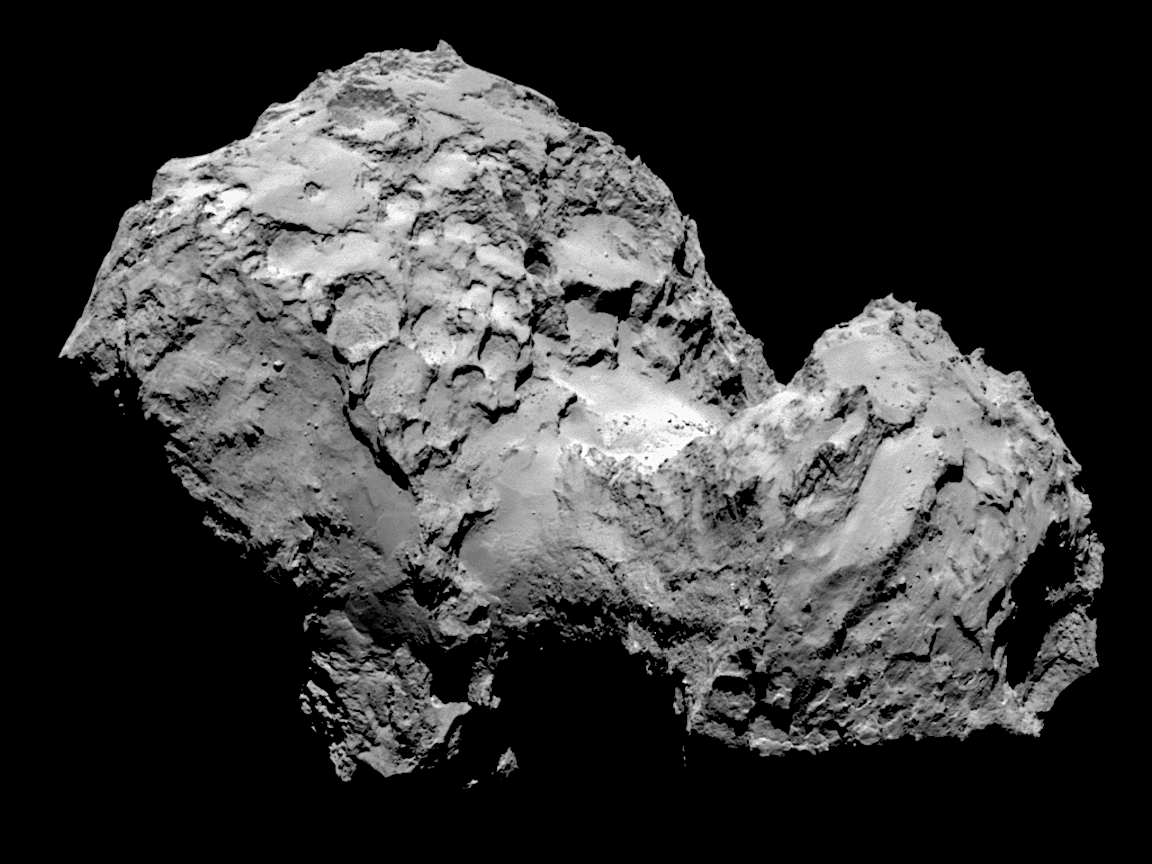
It's a rather odd coincidence that EU theorists found this same shape to be present in discharge experiments, no?
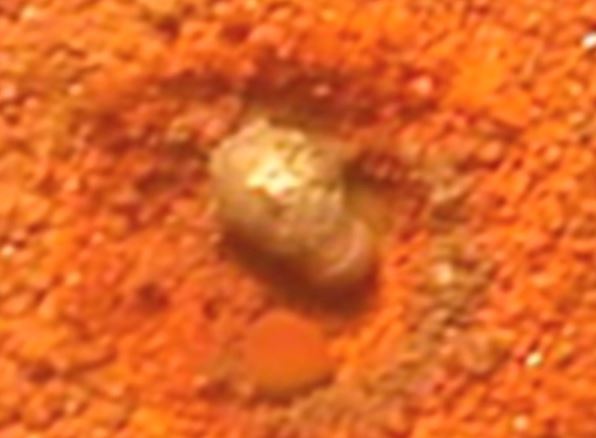
How about a few more?
Comet Borrelly:
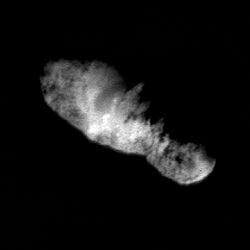
Comet Hartley 2:
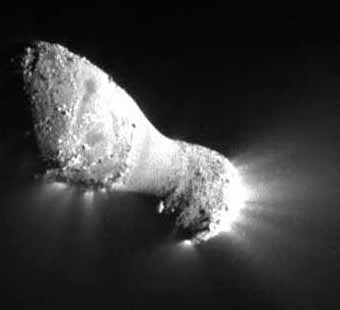
Anyone see a recurring theme here yet?
Actually, this deserves its own post.

It's a rather odd coincidence that EU theorists found this same shape to be present in discharge experiments, no?

How about a few more?
Comet Borrelly:

Comet Hartley 2:

Anyone see a recurring theme here yet?
Actually, this deserves its own post.
edit on 8/6/2014 by AnarchoCapitalist because: (no reason given)
originally posted by: AnarchoCapitalist
melting snowball?
Not a melting snowball. A dusty, dirty conglomerate of frozen volatiles, minerals, and hydrocarbons, that shows activity (coma and tail) due to sublimating ices.
What can you say about the very low mass and very low density estimates for this comet? Have the estimates been completely wrong? If the comet is a massive chunk of rock and/or metal, Rosetta's orbit around it should be different from what the mission control have planned. The spacecraft will be attracted to it more, and move faster than planned. That would throw all the planned orbit maneuvers out of the window.
Can the EU do better science than simply looking at the results of electric lab experiments and say "hey, that looks like photos of comets!" ?
Or, for that matter, simply looking at electric lab experiments and say "hey, that looks like ancient drawings and cave paintings, that means that the ancients witnessed gigantic plasma discharges in the sky, which shaped planets, comets, and asteroids!"
The EU is a joke.
So, going by your logic....instead of the laws of physics, which states that when a celestial object is below a certain mass and size, that it will
not be spherical in nature, which opens up a huge possibilities of an object's shape due to it's spin, material it was made of, how long it took to
cool, which parts took longer to cool, being impacted with other object, etc, etc, etc,.....your logic states: Because something has a similar shape
as another object: they must be the same thing!
Let's check that out.
So that means that this:

MUST be the same as this:

Or this:

Or these:
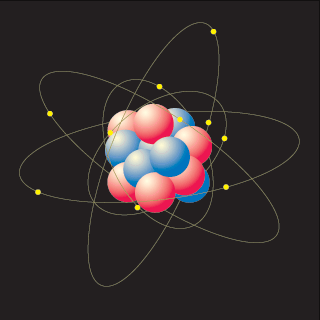
I mean, having shapes that are similar always means that they are the same thing, made up of the same thing according to your logic.
Like how this:

MUST be the same thing as this:

That means that these two things are the same thing too, right?
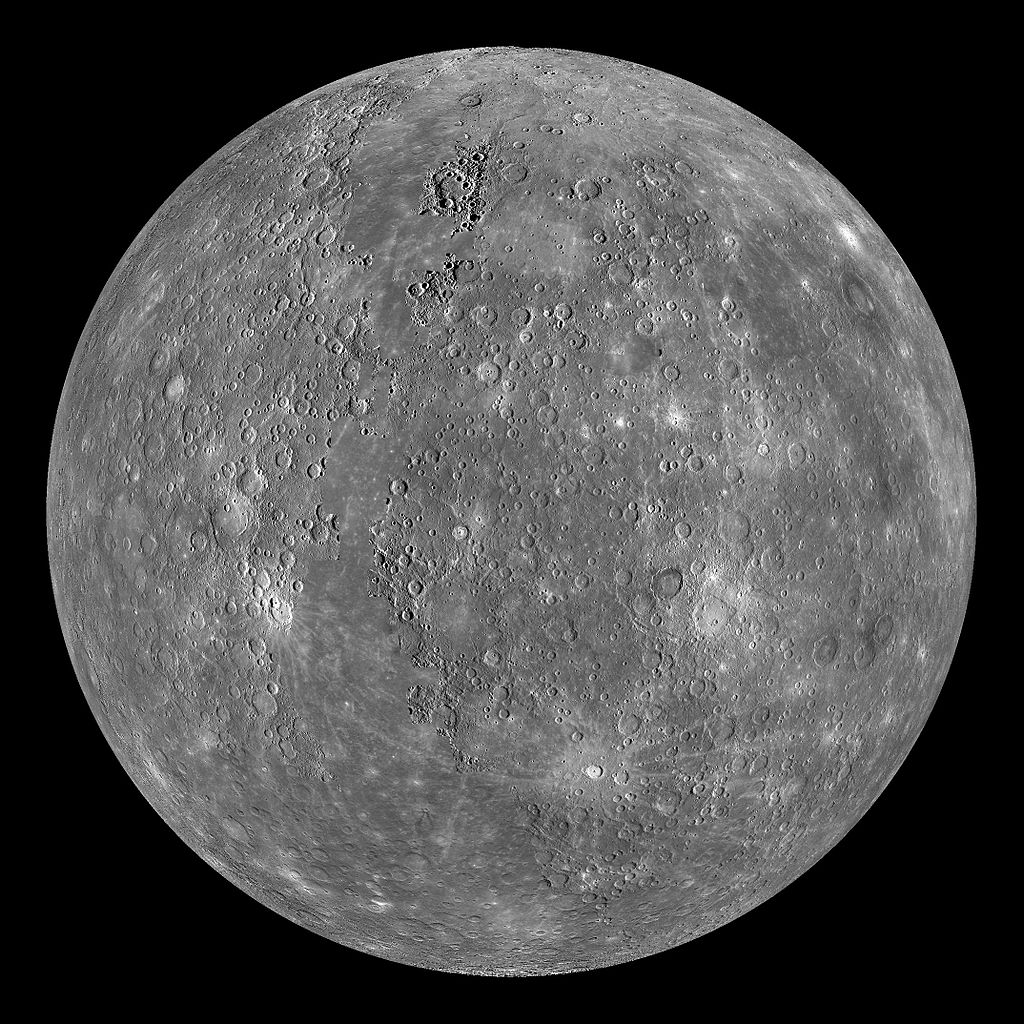

Which they're not. One is a moon and one is a planet.....(hey, anyone tell me which is which?).
No one in the field of astronomy calls comets "Dirty Snowballs". You've been told this over and over and over and over and over and over and over.......which calls into question your ability to learn.
Scientist call comets "Icy Conglomerates", and for good reason. Because "ice" is not always made of water.
Let's wait and see what happens. I mean you did predict that the probe will blow up when it touches the comet in another thread, right? That your EU theory says this MUST happen, right?
Let's check that out.
So that means that this:

MUST be the same as this:

Or this:

Or these:

I mean, having shapes that are similar always means that they are the same thing, made up of the same thing according to your logic.
Like how this:

MUST be the same thing as this:

That means that these two things are the same thing too, right?


Which they're not. One is a moon and one is a planet.....(hey, anyone tell me which is which?).
No one in the field of astronomy calls comets "Dirty Snowballs". You've been told this over and over and over and over and over and over and over.......which calls into question your ability to learn.
Scientist call comets "Icy Conglomerates", and for good reason. Because "ice" is not always made of water.
Let's wait and see what happens. I mean you did predict that the probe will blow up when it touches the comet in another thread, right? That your EU theory says this MUST happen, right?
edit on 6-8-2014 by eriktheawful because: (no reason given)
originally posted by: AnarchoCapitalist
Additional predictions:
"It is expected by Electric Universe proponents that there will be puzzles for the Rosetta team.
That is the crux of the problem with EU or EC "theories". They base their success on the supposed failures of the mainstream scientists. Any surprising discovery, any puzzle, any correction to the previous models, any mysteries that still remain, are somehow the evidence that the mainstream model is all wrong, and that the EU "theory" is all correct.
Real science constantly learns and corrects itself. The EU authors and proponents think they have it all figured out (whereas in reality they haven't figured anything out, beyond pointing fingers and using the rhetoric).
By the way, these new close-up images of the comet look exactly like I would expect a dust-covered rubble of ice and dirt to look like. It doesn't look like a rock to me.
a reply to: wildespace
It's a rock dude.
When the spectrographic data gets processed, they will either find no ice, or less than 1% ice. No comet nucleus has had more than 1% surface ice. They couldn't find any at all on Borrelly. This comet will be no different.
NASA concedes that:
But then they also note that:
So, they admit that there's not enough ice on the surface to account for the coma, and they admit there is not enough ice close beneath the surface to account for the coma, based on the results of the impact.
Of course, you'll never find them discussing these two facts together in the same article. Instead, they would rather ignore those inconsistencies and pretend the ice is simply tens of meters deep beneath the surface.
It's a rock dude.
When the spectrographic data gets processed, they will either find no ice, or less than 1% ice. No comet nucleus has had more than 1% surface ice. They couldn't find any at all on Borrelly. This comet will be no different.
NASA concedes that:
What is significant is that the extent of this ice on Tempel 1's surface is not sufficient to produce the observed abundance of water and its by-products in the comet's coma. The team thus concludes that there are sources of water from beneath the comet's surface that supply the cometary coma as well.
But then they also note that:
"It's pretty clear that this event [Deep Impact] did not produce a gusher," said SWAS principal investigator Gary Melnick of the Harvard-Smithsonian Center for Astrophysics (CfA). "The more optimistic predictions for water output from the impact haven't materialized, at least not yet."
...
Theories about the volatile layers below the surface of short-period comets are going to have to be revised.
So, they admit that there's not enough ice on the surface to account for the coma, and they admit there is not enough ice close beneath the surface to account for the coma, based on the results of the impact.
Of course, you'll never find them discussing these two facts together in the same article. Instead, they would rather ignore those inconsistencies and pretend the ice is simply tens of meters deep beneath the surface.
a reply to: AnarchoCapitalist
But we're not talking just about the surface, are we? A comet may have dust and hydrocarbons on its surface, and very little ice, but may be 90% ice in the interior (if we ignore the voids). Your evaluation of comets' composition is just as shallow as the comets' dust covering.
And again, if this comet has much larger mass and density than estimated, Rosetta's orbital maneuvers and velocity should be way off the planed ones.
But we're not talking just about the surface, are we? A comet may have dust and hydrocarbons on its surface, and very little ice, but may be 90% ice in the interior (if we ignore the voids). Your evaluation of comets' composition is just as shallow as the comets' dust covering.
And again, if this comet has much larger mass and density than estimated, Rosetta's orbital maneuvers and velocity should be way off the planed ones.
a reply to: wildespace
There's no ice.
You'll see what I mean once the comet starts discharging.
Here's what they will find:
No "vent" holes in the rock will be directly imaged.
The discharges will appear to change location and move around the surface.
The discharge origins will be difficult or impossible to identify.
The discharges will appear to come from ridges, crater walls or mesas.
We may observe the ablation of crater walls, ridge lines or mesas.
The dust will be finely divided, like carbon black talcum powder. The lander may end up covered in soot, causing problems for the solar array.
We may observe discharges producing a coronal glow in darkness.
There's no ice.
You'll see what I mean once the comet starts discharging.
Here's what they will find:
No "vent" holes in the rock will be directly imaged.
The discharges will appear to change location and move around the surface.
The discharge origins will be difficult or impossible to identify.
The discharges will appear to come from ridges, crater walls or mesas.
We may observe the ablation of crater walls, ridge lines or mesas.
The dust will be finely divided, like carbon black talcum powder. The lander may end up covered in soot, causing problems for the solar array.
We may observe discharges producing a coronal glow in darkness.
originally posted by: AnarchoCapitalist
a reply to: wildespace
It's a rock dude.
originally posted by: AnarchoCapitalist
a reply to: wildespace
There's no ice.
Great job with blind assumptions, dude, keep them coming. I'll base my conclusions on the real scientific data.
a reply to: wildespace
I don't think it will be long before you will be choking on those words. Group councilling will be available for those who have trouble adjusting their realities to the upcoming paradigm shift.
The EU is a joke.
I don't think it will be long before you will be choking on those words. Group councilling will be available for those who have trouble adjusting their realities to the upcoming paradigm shift.
originally posted by: GaryN
a reply to: wildespace
The EU is a joke.
I don't think it will be long before you will be choking on those words. Group councilling will be available for those who have trouble adjusting their realities to the upcoming paradigm shift.
Man, I'd love to choke on my words. I'd really love to see the EU authors start doing some science and get the results. Show the mainstream astronomers that comets are solid rocky bodies that are interacting with the Sun electrically. Show that the Sun is a glow discharge of a galactic electric current. Show that electric machining on a gigantic scale created craters, mountain ranges, and canyons in the Solar System, as well as knocked off all those asteroids and comets. I'd love to see some science in support of all that.
I think there's a Nobel Prize waiting for such paradigm shift. That's what science is about - discovering, testing, and learning throgh confirmation.
But all I've seen so far are badly-written articles and preachy Youtube videos.
edit on 8-8-2014 by wildespace because: (no reason
given)
Looks like Philae didn't explode, once again confirming that EU theory is correct in predicting that it would either explode or it wouldn't!
originally posted by: DJW001
Looks like Philae didn't explode, once again confirming that EU theory is correct in predicting that it would either explode or it wouldn't!
It's not over yet.
Here's a complete list of predictions I made about this event:
5. The lander may short out or explode as it approaches the comet. It’s possible that a massive explosion could occur if a large electrical exchange were to take place between the lander and the comet. The lander could malfunction due to electrical interference.
12. Philae probe probe will have difficulty sticking to the surface of Chury. The lander was designed to fire a harpoon into ice, and then winch itself to the surface. After landing, the feet of the probe have ice augers designed to drill into ice. Given that EU theory assumes the comet is solid rock, the probe may have difficulty penetrating the surface of this rock when it attempts to land.
Word is coming in that the harpoons did not fire and that communications with the lander are sporadic.
More analysis of @Philae2014 telemetry indicates harpoons did not fire as 1st thought. Lander in gr8 shape. Team looking at refire options
shortly after landing, the communications link to Rosetta began dropping and coming back online. This continues at the present time. It should have been a steady signal.
The probe may not have been zapped by a lighting bolt, but the electrical environment surrounding the probe is going to create issues.
edit on 11/12/2014 by AnarchoCapitalist because: (no reason given)
Or else it has caused the nucleus to start rotating, making contact between the lander and Rosseti sporadic.a reply to:
AnarchoCapitalist
What this comes down to to me is that we are most obviously being lied to on a regular basis by the same people who are studying what is out there and
that the truth is well known already.
Why would that be do you think?
Why would that be do you think?
new topics
-
LA Mayor Bass Demanded $49M in Additional LAFD Cuts One Week Before Wildfires
Mainstream News: 6 minutes ago -
Sepultura - Territory - With New Drummer Greyson Nekrutman
Music: 1 hours ago -
Carry On!
Short Stories: 1 hours ago -
This should be plastered all over the airwaves
Mainstream News: 7 hours ago -
Oh, Good Gosh. “Kremlin Warns Stay Away from Greenland.”
World War Three: 9 hours ago -
Archbisop Vigano Warns of Deep State and Deep Church
New World Order: 9 hours ago
top topics
-
This should be plastered all over the airwaves
Mainstream News: 7 hours ago, 19 flags -
Archbisop Vigano Warns of Deep State and Deep Church
New World Order: 9 hours ago, 14 flags -
Oh, Good Gosh. “Kremlin Warns Stay Away from Greenland.”
World War Three: 9 hours ago, 11 flags -
Fire insurance in LA withdrawn months ago
General Conspiracies: 17 hours ago, 9 flags -
A Flash of Beauty: Bigfoot Revealed ( documentary )
Cryptozoology: 15 hours ago, 7 flags -
LA Mayor Bass Demanded $49M in Additional LAFD Cuts One Week Before Wildfires
Mainstream News: 7 minutes ago, 3 flags -
Carry On!
Short Stories: 1 hours ago, 1 flags -
Sepultura - Territory - With New Drummer Greyson Nekrutman
Music: 1 hours ago, 0 flags
active topics
-
LA Mayor Bass Demanded $49M in Additional LAFD Cuts One Week Before Wildfires
Mainstream News • 0 • : CarlLaFong -
To become president, Zelensky had to learn Ukrainian
Political Conspiracies • 43 • : Dalamax -
Archbisop Vigano Warns of Deep State and Deep Church
New World Order • 7 • : DontTreadOnMe -
Post A Funny (T&C Friendly) Pic Part IV: The LOL awakens!
General Chit Chat • 8013 • : KrustyKrab -
Judge rules president-elect Donald Trump must be sentenced in 'hush money' trial
US Political Madness • 114 • : xuenchen -
-@TH3WH17ERABB17- -Q- ---TIME TO SHOW THE WORLD--- -Part- --44--
Dissecting Disinformation • 3986 • : nerbot -
Los Angeles brush fires latest: 2 blazes threaten structures, prompt evacuations
Mainstream News • 342 • : KrustyKrab -
This should be plastered all over the airwaves
Mainstream News • 44 • : Dalamax -
Candidate TRUMP Now Has Crazy Judge JUAN MERCHAN After Him - The Stormy Daniels Hush-Money Case.
Political Conspiracies • 2187 • : NoCorruptionAllowed -
Trump says ownership of Greenland 'is an absolute necessity'
Other Current Events • 153 • : fringeofthefringe
